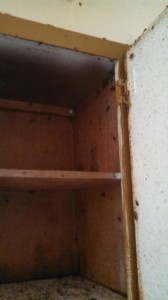German cockroaches are one of the most commonly encountered species of roaches.
They hold top priority as far as important due to their disease-carrying abilities. German roaches are known vectors of numerous types of bacteria, half a dozen parasitic worms, and several other pathogens. They are also responsible for household allergens and are even known to cause asthma in children.
Allergens are a result of deceased roaches, droppings, and cast skins building up within the home.
Where Do German Cockroaches Infest Colorado Homes?
German cockroaches are primarily found in kitchens and bathrooms due to shared plumbing; however, they can spread to any room within the home where they find suitable food sources. Leaking pipes and other high moisture areas attract roaches due to the water source. German cockroaches spend the majority of their time in harborages in cracks and crevices near their food sources. Primarily active during the night, daylight sightings may indicate a severe infestation and should be exterminated immediately if not sooner.
In Colorado, German cockroaches are found only indoors where warmer temperatures and sustainable food sources are available. German roaches will consume anything that is composed of organic material including food, cardboard, waste (sewage), and decaying matter.
What Do German Cockroaches Look Like?
Bacteria and other pathogens are picked up from these items and remain active within the body of the roach, which is a big reason why you need to exterminate against these creatures.
They are roughly ½ inch in length, oval in shape and light brown with two dark stripes on their backs. Despite their wings, adults are flightless. Nymphs lack wings but still have stripes on their back. Their antennae are long and thin. German roaches move very quickly and are often described as scattering when lights are turned on.
Exterminating Against German Cockroaches in Colorado
Sanitation is an extremely important part of German cockroach control and the extermination process. Eliminating food sources by immediately cleaning up spills and completing a deep clean on the home including trash containers will help to limit activity. Repairing water leaks or removing potential water sources will also help to control activity. Glue traps can be used to monitor activity and determine areas of greatest concentrations; however, they will not resolve a roach infestation.
Food markets and commercial kitchens are also prone to German cockroach infestations due to the readily available food sources that are present. Contacting a pest control professional is often an essential step in controlling and eliminating a German roach infestation. Foggers/bug bombs as well as many over the counter sprays result in spreading German roach activity to areas of the previous inactivity and are not recommended. Baits, growth regulators, and non-repellent types of sprays are often the pesticides of choice when combating a roach infestation. Rapid response to a known roach infestation typically provides the fastest resolution to the situation as populations tend to increase rapidly.
If you’ve noticed a creepy-crawly German Cockroach in your Colorado home — don’t wait. Contact us at Mug-A-Bug Pest Control and get rid of these creatures today!
